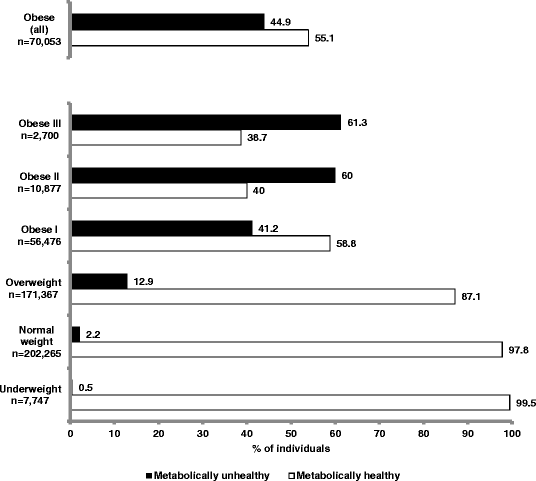Prevalence and clinical characteristics of metabolically healthy obese individuals and other obese/non-obese metabolic phenotypes in a working population: results from the Icaria study
- PMID: 27036105
- PMCID: PMC4818410
- DOI: 10.1186/s12889-016-2921-4
Prevalence and clinical characteristics of metabolically healthy obese individuals and other obese/non-obese metabolic phenotypes in a working population: results from the Icaria study
Abstract
Background: Metabolically healthy obese (MHO) phenotype may present with distinct characteristics compared with those with a metabolically unhealthy obese phenotype. Epidemiologic data on the distribution of these conditions in the working population are lacking. We aimed to evaluate the prevalence and clinical characteristics of MHO and other obese/non-obese metabolic phenotypes in a working population.
Methods: Cross-sectional analysis of all subjects who had undergone a medical examination with Ibermutuamur Prevention Society from May 2004 to December 2007. Participants were classified into 5 categories according to their body mass index (BMI); within each of these categories, participants were further classified as metabolically healthy (MH) or metabolically unhealthy (MUH) according to the modified NCEP-ATPIII criteria. A logistic regression analysis was performed to evaluate some clinically relevant factors associated with a MH status.
Results: In the overall population, the prevalence of the MHO phenotype was 8.6%. The proportions of MH individuals in the overweight and obese categories were: 87.1% (overweight) and 55.5% (obese I-III [58.8, 40.0, and 38.7% of the obese I, II, and III categories, respectively]). When the overweight and obese categories were considered, compared with individuals who were MUH, those who were MH tended to be younger and more likely to be female or participate in physical exercise; they were also less likely to smoke, or to be a heavy drinker. In the underweight and normal weight categories, compared with individuals who were MH, those who were MUH were more likely to be older, male, manual (blue collar) workers, smokers and heavy drinkers. Among participants in the MUH, normal weight group, the proportion of individuals with a sedentary lifestyle was higher relative to those in the MH, normal weight group. The factors more strongly associated with the MUH phenotype were BMI and age, followed by the presence of hypercholesterolemia, male sex, being a smoker, being a heavy drinker, and lack of physical exercise.
Conclusions: The prevalence of individuals with a MHO phenotype in the working population is high. This population may constitute an appropriate target group in whom to implement lifestyle modification initiatives to reduce the likelihood of transition to a MUH phenotype.
Keywords: Metabolic risk factors; Metabolically healthy obesity; Prevalence; Working population.
Figures
Similar articles
-
Variable patterns of obesity and cardiometabolic phenotypes and their association with lifestyle factors in the Di@bet.es study.Nutr Metab Cardiovasc Dis. 2014 Sep;24(9):947-55. doi: 10.1016/j.numecd.2014.04.019. Epub 2014 Jun 9. Nutr Metab Cardiovasc Dis. 2014. PMID: 24984822
-
Metabolically healthy obese and unhealthy normal weight in Iranian adult population: Prevalence and the associated factors.Diabetes Metab Syndr. 2018 Apr-Jun;12(2):129-134. doi: 10.1016/j.dsx.2017.11.005. Epub 2017 Nov 23. Diabetes Metab Syndr. 2018. PMID: 29196231
-
Defining metabolically healthy obesity: role of dietary and lifestyle factors.PLoS One. 2013 Oct 17;8(10):e76188. doi: 10.1371/journal.pone.0076188. eCollection 2013. PLoS One. 2013. PMID: 24146838 Free PMC article.
-
Relations of Metabolically Healthy and Unhealthy Obesity to Digital Vascular Function in Three Community-Based Cohorts: A Meta-Analysis.J Am Heart Assoc. 2017 Mar 8;6(3):e004199. doi: 10.1161/JAHA.116.004199. J Am Heart Assoc. 2017. PMID: 28275071 Free PMC article. Review.
-
Metabolic phenotypes of obese, overweight, and normal weight individuals and risk of chronic kidney disease: a systematic review and meta-analysis.Arch Endocrinol Metab. 2019 Jul 29;63(4):427-437. doi: 10.20945/2359-3997000000149. Arch Endocrinol Metab. 2019. PMID: 31365625 Free PMC article.
Cited by
-
Impact of central obesity on prognostic outcome of triple negative breast cancer in Chinese women.Springerplus. 2016 May 11;5:594. doi: 10.1186/s40064-016-2200-y. eCollection 2016. Springerplus. 2016. PMID: 27247890 Free PMC article.
-
Genetic and nongenetic factors explaining metabolically healthy and unhealthy phenotypes in participants with excessive adiposity: relevance for personalized nutrition.Ther Adv Endocrinol Metab. 2019 Sep 18;10:2042018819877303. doi: 10.1177/2042018819877303. eCollection 2019. Ther Adv Endocrinol Metab. 2019. PMID: 31555433 Free PMC article.
-
Dietary patterns and metabolic phenotypes in Brazilian adults: a population-based cross-sectional study.Public Health Nutr. 2019 Dec;22(18):3377-3383. doi: 10.1017/S1368980019002593. Epub 2019 Oct 1. Public Health Nutr. 2019. PMID: 31571548 Free PMC article.
-
Distribution of metabolic/obese phenotypes and association with diabetes: 5 years' cohort based on 22,276 elderly.Endocrine. 2018 Oct;62(1):107-115. doi: 10.1007/s12020-018-1672-7. Epub 2018 Jul 13. Endocrine. 2018. PMID: 30006803
-
Beta-Cell Function, Self-rated Health, and Lifestyle Habits in 64-Year-Old Swedish Women with Metabolically Healthy Obesity Phenotype.J Obes Metab Syndr. 2020 Mar 30;29(1):39-46. doi: 10.7570/jomes19078. J Obes Metab Syndr. 2020. PMID: 32200605 Free PMC article.
References
-
- Klein S, Burke LE, Bray GA, Blair S, Allison DB, Pi-Sunyer X, Hong Y, Eckel RH. Clinical implications of obesity with specific focus on cardiovascular disease: a statement for professionals from the American Heart Association council on nutrition, physical activity, and metabolism, endorsed by the American College of Cardiology Foundation. Circulation. 2004;110:2952–67. doi: 10.1161/01.CIR.0000145546.97738.1E. - DOI - PubMed
-
- Berrington De Gonzalez A, Hartge P, Cerhan JR, Flint AJ, Hannan L, MacInnis RJ, Moore SC, Tobias GS, Anton-Culver H, Freeman LB, Beeson WL, Clipp SL, English DR, Folsom AR, Freedman M, Giles G, Hakansson N, Henderson KD, Hoffman-Bolton J, Hoppin JA, Koenig KL, Lee I, Linet MS, Park Y, Pocobelli G, Schatzkin A, Sesso HD, Weiderpass E, Willcox BJ, Wolk A, et al. Body-mass index and mortality among 1.46 million white adults. N Engl J Med. 2010;363:2211–9. doi: 10.1056/NEJMoa1000367. - DOI - PMC - PubMed
Publication types
MeSH terms
Substances
LinkOut - more resources
Full Text Sources
Other Literature Sources
Medical


